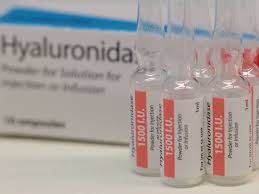What is Filler Dissolving?
Dermal filler dissolving is the process of breaking down and removing hyaluronic acid (HA)-based dermal fillers from the skin using an enzyme called hyaluronidase (often called Hyalase® in the UK).
The enzyme works by breaking down the HA chains in the filler, allowing it to be absorbed naturally by the body.
While dermal fillers are generally safe in trained hands, they are not permanent, and in some cases, they may need to be dissolved quickly to address complications or undesired results.
Reasons for Dissolving Dermal Fillers
Fillers can be dissolved for both medical and aesthetic reasons. The most common include:
Medical Reasons (Urgent)
- Vascular Occlusion – When filler inadvertently enters or compresses a blood vessel, reducing or blocking blood flow. This is a serious emergency as it can lead to skin necrosis, blindness, or stroke if not treated promptly.
- Allergic Reaction or Hypersensitivity – Though rare, an individual may react to the filler or one of its ingredients, causing swelling, redness, and discomfort.
- Infection – If an infection develops at or near the filler site, dissolving the filler can help resolve the issue alongside medical treatment.
- Nodules or Lumps – Firm, sometimes painful lumps can occur, often due to inflammation, granuloma formation, or biofilm.
- Migration of Filler – When filler moves from the original placement area into surrounding tissues, causing asymmetry or unnatural appearances.
Aesthetic Reasons (Elective)
- Overfilling or “Pillow Face” – When too much filler creates an unnatural or undesirable look.
- Asymmetry or Uneven Results – Dissolving can help correct imbalances before refilling.
- Change in Personal Preference – A client may simply no longer want filler and prefer to return to their natural appearance.
- Preparation for Surgery or New Treatment – Some surgical or non-surgical treatments require a “clean slate,” meaning old filler needs to be removed first.
How is it Done?
- Medical Consultation & Patch Test – A prescriber assesses the situation, confirms the filler type, and checks for allergies to hyaluronidase.
- Prescription & Preparation – Hyaluronidase is a prescription-only medicine (POM) in the UK. It must be prescribed by a qualified prescriber (doctor, dentist, nurse prescriber, or pharmacist prescriber).
- Injection of Hyaluronidase – The enzyme is injected directly into the area containing filler. It begins breaking down the filler almost immediately, with noticeable effects within 24–48 hours.
- Aftercare – Clients may experience mild swelling or bruising. Follow-up is often arranged to ensure the filler has dissolved fully.
UK Legislation and Why Non-Medics Can Inject Fillers but Not Hyalase
- Dermal fillers do not currently need to be prescribed so anyone can legally inject them — there is no law requiring medical qualifications. However, this is widely criticised due to safety concerns.

- Botulinum toxin (Botox) is a prescription-only medicine. It must be prescribed by a qualified prescriber, but the injection itself can be delegated to someone else under the prescriber’s supervision.
- Hyaluronidase is also a prescription-only medicine, but with a crucial difference:
- It is often used in medical emergencies (e.g., vascular occlusion) and requires immediate, skilled administration.
- The law and best-practice guidelines require that it is both prescribed and administered by a prescriber or given under direct medical supervision.
- Non-medics cannot legally keep or inject hyaluronidase.
This legal framework means that while non-medics can inject fillers, they cannot treat serious filler complications themselves — creating a significant patient safety risk if something goes wrong.
Why Safety Matters
The ability to dissolve fillers quickly can mean the difference between a temporary side effect and permanent damage.
For this reason, many industry bodies — including Save Face, the Joint Council for Cosmetic Practitioners (JCCP), and the British College of Aesthetic Medicine (BCAM) — strongly recommend that all aesthetic injectables are carried out by trained medical professionals.

